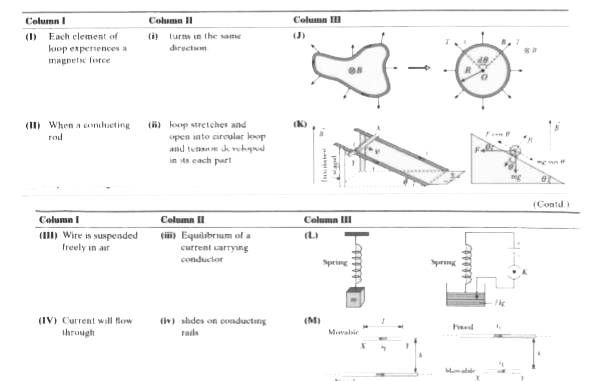If a current is passed in a spring then
it is compressed
it gets expanded
it performs a vertical SHM
remains unchanged
The correct Answer is:A
To solve the question "If a current is passed in a spring then...", we need to analyze the behavior of the spring when an electric current flows through it. Here’s a step-by-step solution:
Step 1: Understanding the Setup
When a current flows through a spring, we are essentially dealing with a coil of wire. The spring can be thought of as a series of loops or coils that can interact with each other when current flows through them.
Hint: Consider how current in a coil generates a magnetic field.
Step 2: Magnetic Field Generation
When an electric current passes through a coil (or spring), it generates a magnetic field around it. The direction of the magnetic field can be determined using the right-hand rule.
Hint: Remember that current creates a magnetic field that can exert forces on other currents.
Step 3: Interaction Between Adjacent Coils
In the case of a spring, the adjacent coils will experience a magnetic force due to the current flowing through them. If the currents in the adjacent coils are in the same direction, they will attract each other.
Hint: Think about how two parallel wires carrying current interact with each other.
Step 4: Resulting Motion of the Spring
Since the adjacent coils attract each other, this results in a compressive force acting on the spring. As a result, the spring will compress due to the attractive forces between the adjacent coils.
Hint: Visualize how the coils would move closer together when they are attracted.
Step 5: Conclusion
Based on the analysis, when a current is passed through a spring, the spring will be compressed due to the attractive forces between the adjacent coils.
Final Answer: The spring is compressed (Option A).
When a current flows through a spring, we are essentially dealing with a coil of wire. The spring can be thought of as a series of loops or coils that can interact with each other when current flows through them.
When an electric current passes through a coil (or spring), it generates a magnetic field around it. The direction of the magnetic field can be determined using the right-hand rule.
In the case of a spring, the adjacent coils will experience a magnetic force due to the current flowing through them. If the currents in the adjacent coils are in the same direction, they will attract each other.
Since the adjacent coils attract each other, this results in a compressive force acting on the spring. As a result, the spring will compress due to the attractive forces between the adjacent coils.
Based on the analysis, when a current is passed through a spring, the spring will be compressed due to the attractive forces between the adjacent coils.
Topper's Solved these Questions
- BOOK - NIKITA PUBLICATIONCHAPTER - MAGNETIC EFFECT OF ELECTRIC CURRENTEXERCISE - MCQs (Sensitivity and accuracy of M.C.G.)1videos
MAGNETIC EFFECT OF ELECTRIC CURRENT
- BOOK - NIKITA PUBLICATIONCHAPTER - KINETIC THEORY OF GASES & RADIATION EXERCISE - MCQs (Question Given in MHT-CET)79videos
KINETIC THEORY OF GASES & RADIATION
- BOOK - NIKITA PUBLICATIONCHAPTER - MAGNETISM EXERCISE - MCQs249videos
MAGNETISM
Similar Questions
When a current is passed in a moving coil galvanometer the coil gets deflected because
View SolutionConsider standrad cases for force on current carrying conductors. In the given table, Column I shows the action of current on the element, Column II shows the effect of the current in the element, Column II shows the effect of the current in the element and Column III shows the figure of the element under force of current and magnetic field and its equivalent figure in general mechanical form.

What happens when current is passed through a spring ?View Solution
Knowledge Check
- Question 1 - Select One
If a current is passed in a spring, it
Agets compressedBgets expandedCoscillatesDremains unchanged - Question 2 - Select One
If a current is passed through a spring then the spring will
AexpandBcompressCremains sameDNone of these - Question 3 - Select One
When √3 ampere current is passed in a tangent galvanometer, there is a deflection of 30∘ in it. The deflection obtained when 3 amperes current is passed, is
A30∘B45∘C60∘D75∘
If the current is passed into the solution of the electrolyte
View SolutionIf the current is passed into the solution of the electrolyte
View SolutionIf the current is passed into the solution of the electrolyte
View SolutionWhen a current is passed in a conductor, 3∘C rise in temperature is observed. If the strength of current is made thrice, then rise in temperature will approximately be
View SolutionWhen 10A current is passed for 80 min, the volume of hydrogen gas liberated is
View Solution

